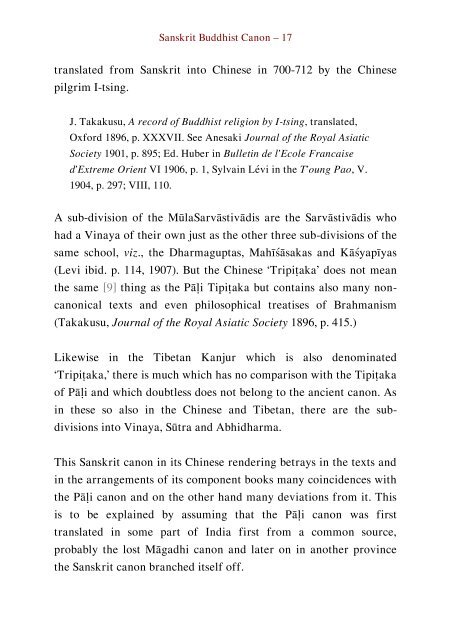Literary History of Sanskrit Buddhism
A study by J. K. Nariman of Sanskrit Buddhism from the Early Buddhist Tradition up to the Mahayana texts proper.
A study by J. K. Nariman of Sanskrit Buddhism from the Early Buddhist Tradition up to the Mahayana texts proper.
Create successful ePaper yourself
Turn your PDF publications into a flip-book with our unique Google optimized e-Paper software.
<strong>Sanskrit</strong> Buddhist Canon – 17<br />
translated from <strong>Sanskrit</strong> into Chinese in 700-712 by the Chinese<br />
pilgrim I-tsing.<br />
J. Takakusu, A record <strong>of</strong> Buddhist religion by I-tsing, translated,<br />
Oxford 1896, p. XXXVII. See Anesaki Journal <strong>of</strong> the Royal Asiatic<br />
Society 1901, p. 895; Ed. Huber in Bulletin de l’Ecole Francaise<br />
d’Extreme Orient VI 1906, p. 1, Sylvain Lévi in the T’oung Pao, V.<br />
1904, p. 297; VIII, 110.<br />
A sub-division <strong>of</strong> the MūlaSarvāstivādis are the Sarvāstivādis who<br />
had a Vinaya <strong>of</strong> their own just as the other three sub-divisions <strong>of</strong> the<br />
same school, viz., the Dharmaguptas, Mahīśāsakas and Kāśyapīyas<br />
(Levi ibid. p. 114, 1907). But the Chinese ‘Tripiṭaka’ does not mean<br />
the same [9] thing as the Pāḷi Tipiṭaka but contains also many noncanonical<br />
texts and even philosophical treatises <strong>of</strong> Brahmanism<br />
(Takakusu, Journal <strong>of</strong> the Royal Asiatic Society 1896, p. 415.)<br />
Likewise in the Tibetan Kanjur which is also denominated<br />
‘Tripiṭaka,’ there is much which has no comparison with the Tipiṭaka<br />
<strong>of</strong> Pāḷi and which doubtless does not belong to the ancient canon. As<br />
in these so also in the Chinese and Tibetan, there are the subdivisions<br />
into Vinaya, Sūtra and Abhidharma.<br />
This <strong>Sanskrit</strong> canon in its Chinese rendering betrays in the texts and<br />
in the arrangements <strong>of</strong> its component books many coincidences with<br />
the Pāḷi canon and on the other hand many deviations from it. This<br />
is to be explained by assuming that the Pāḷi canon was first<br />
translated in some part <strong>of</strong> India first from a common source,<br />
probably the lost Māgadhi canon and later on in another province<br />
the <strong>Sanskrit</strong> canon branched itself <strong>of</strong>f.


















